I guess I should take all this advice to heart and attach the foot pedal to my new machine. It is a stick/tig/plasma machine and works very well in all modes. I just find that focusing on what my hands are doing while tig welding doesn’t leave enough brain cells available to add foot action. Oh well, lots of practice needed.
You are using an out of date browser. It may not display this or other websites correctly.
You should upgrade or use an alternative browser.
You should upgrade or use an alternative browser.
Thumper--a 1 3/8" bore i.c. engine
- Thread starter Brian Rupnow
- Start date

Help Support Home Model Engine Machinist Forum:
This site may earn a commission from merchant affiliate
links, including eBay, Amazon, and others.
Shopgeezer, when I first started doing TIG, I worried about trying to coordinate my foot along with my hands - it seemed like one more thing to have to keep track of.
What I found was that I didn't have to think about it - or at least, hardly ever think specifically about it. It seems to work very naturally and instinctively - or rather than "instinctively," probably some sort of muscle memory related to driving for the last 45 years. Just like pressing the gas pedal on the car, I don't think about doing it - when I need to speed up or slow down, I just do it.
I hope that will be your experience as well!
What I found was that I didn't have to think about it - or at least, hardly ever think specifically about it. It seems to work very naturally and instinctively - or rather than "instinctively," probably some sort of muscle memory related to driving for the last 45 years. Just like pressing the gas pedal on the car, I don't think about doing it - when I need to speed up or slow down, I just do it.
I hope that will be your experience as well!
The music never stops---TIG practice is going slowly. I decided that I had sufficient material to make up a fixture to hold the second flywheel/fan for welding, so I did. There is a fellow one of my forums calling himself "Tungsten Dipper". Lets just say that with my TIG progress, I have a full understanding of his name now!!
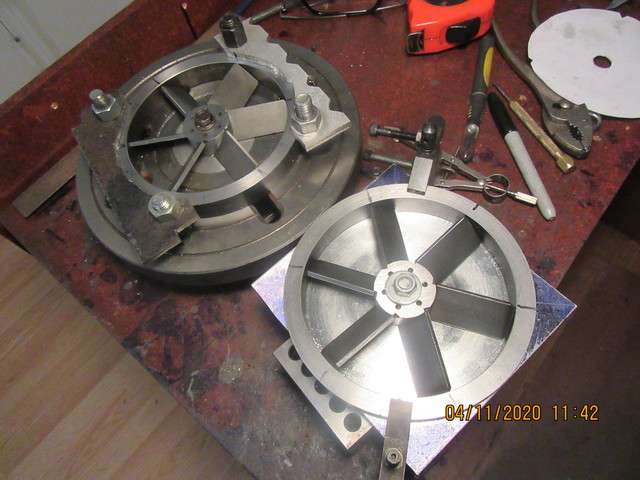

Brian, one thing that I find helpful with TIG welding is to get my face close, far closer than I would for stick welding. I am both nearsighted and have presbyopia, but I find that I can see better if I take my glasses off and get up close. Others talk about using magnifying lenses in their welding hoods - I've tried one, but never got it to where I thought it was helpful.
Oh, another thought - when it comes to tacking those blades in place, you might use "flash tacks" - relatively high amperage, electrode positioned very close to (< 1/16" from) the joint, good sharp electrode, no filler. Get it positioned, then get on and off full pedal - maybe 1/3 of a second total, if that much. What you are after is a quick burst that creates a very small fusion tack.
Oh, another thought - when it comes to tacking those blades in place, you might use "flash tacks" - relatively high amperage, electrode positioned very close to (< 1/16" from) the joint, good sharp electrode, no filler. Get it positioned, then get on and off full pedal - maybe 1/3 of a second total, if that much. What you are after is a quick burst that creates a very small fusion tack.
You just want me to set my beard on fire, dontcha.
Todays message concerns ergonomics. I find that if I hold the tig torch in my right hand, I can run a decent bead IF I brace my right wrist with my left hand. That is fine for running a bead with no filler rod, but when holding filler rod in my left hand, my right hand shakes like a toad eating chain lightning.---So, back for a closer look at the Youtube videos.--Ah Ha--The good videos shown by weld.com shows the instructor working with a much higher table, on which he can rest his right wrist. I wasn't about to build a higher table, but since I am in "learning mode", I can make my existing table a little higher. That is what you see here. A temporary "table riser" made from a few pieces of 2" x 8". This raises the height of my work area 6 1/2" higher than the original table top. Now I can hold the torch steady by bracing my right wrist on the temporary table top while my left hand holds the filler rod.
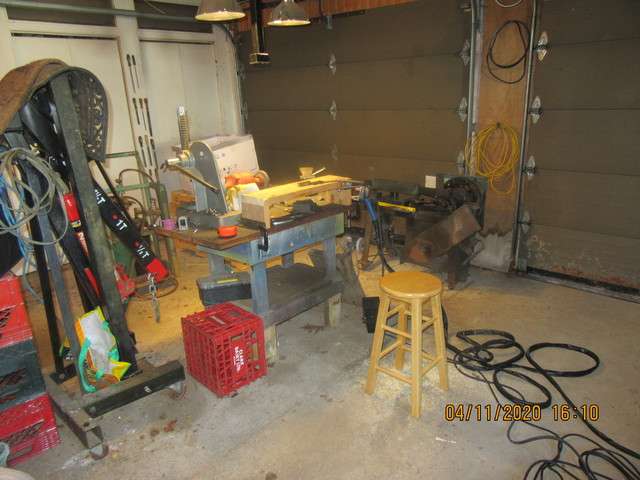
Todays message concerns ergonomics. I find that if I hold the tig torch in my right hand, I can run a decent bead IF I brace my right wrist with my left hand. That is fine for running a bead with no filler rod, but when holding filler rod in my left hand, my right hand shakes like a toad eating chain lightning.---So, back for a closer look at the Youtube videos.--Ah Ha--The good videos shown by weld.com shows the instructor working with a much higher table, on which he can rest his right wrist. I wasn't about to build a higher table, but since I am in "learning mode", I can make my existing table a little higher. That is what you see here. A temporary "table riser" made from a few pieces of 2" x 8". This raises the height of my work area 6 1/2" higher than the original table top. Now I can hold the torch steady by bracing my right wrist on the temporary table top while my left hand holds the filler rod.

Hmm, hadn't thought about the proximity of the beard to the arc - maybe that's not such a good idea after all!
Definitely you want to have some way of bracing your hand - whenever I watch Jody on Tips and Tricks, he always makes practice passes, emulating how his hand will move throughout the bead, and adjusting if it is not going to be possible to move smoothly. I try to do the same ...
Definitely you want to have some way of bracing your hand - whenever I watch Jody on Tips and Tricks, he always makes practice passes, emulating how his hand will move throughout the bead, and adjusting if it is not going to be possible to move smoothly. I try to do the same ...
![DreamPlan Home Design and Landscaping Software Free for Windows [PC Download]](https://m.media-amazon.com/images/I/51kvZH2dVLL._SL500_.jpg)
$0.00
DreamPlan Home Design and Landscaping Software Free for Windows [PC Download]
Amazon.com Services LLC

$599.00
$699.00
FoxAlien Masuter Pro CNC Router Machine, Upgraded 3-Axis Engraving All-Metal Milling Machine for Wood Acrylic MDF Nylon Carving Cutting
FoxAlien Official

$89.99
Outdoor Wood Boiler Water Treatment Rust Inhibitor- AmTech 300 & Test Kit
Alternative Heating & Supplies

$99.99
AHS Outdoor Wood Boiler Yearly Maintenance Kit with Water Treatment - ProTech 300 & Test Kit
Alternative Heating & Supplies

$37.38
$49.99
Becker CAD 12 3D - professional CAD software for 2D + 3D design and modelling - for 3 PCs - 100% compatible with AutoCAD
momox Shop

$39.99
$49.99
Sunnytech Low Temperature Stirling Engine Motor Steam Heat Education Model Toy Kit For mechanical skills (LT001)
stirlingtechonline

$17.29
$18.99
Product-Led SEO: The Why Behind Building Your Organic Growth Strategy
The Quality Books
I just finished what may be the last bit of machining for Thumper. This is the starter hub which bolts to one of the flywheels. As of right now I have no excuse to keep me away from my new TIG welder.
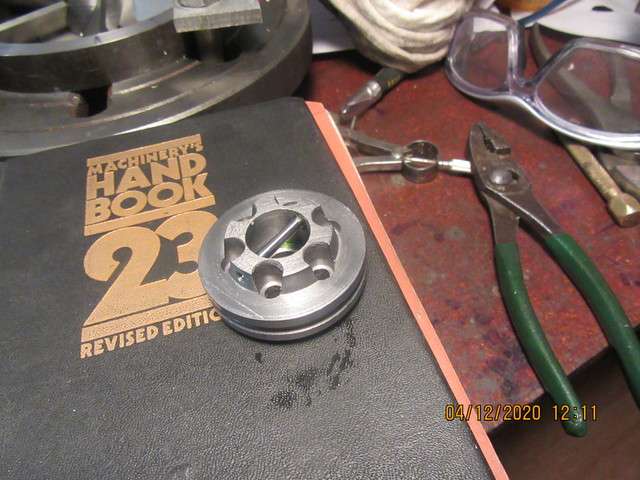

I use the “TIG Finger” over my lightweight glove on my torch hand (right hand for me) to keep me from flinching due to heat build up when bracing my torch hand on the weld piece. No more burns while getting that last bit of bead done, and on aluminum, the heat travels to your hand real fast!
Here’s a link to the one I use, but there are many others:
https://www.arc-zone.com/TIG-Finger...w5RC5-DufCg8AjwoWRJxwJkWvFejyDrYaAlG3EALw_wcB
John W
Here’s a link to the one I use, but there are many others:
https://www.arc-zone.com/TIG-Finger...w5RC5-DufCg8AjwoWRJxwJkWvFejyDrYaAlG3EALw_wcB
John W
I've seen those advertised, but haven't gotten into this tig weld thing to need one yet.
The new tig welder calls for a lot of coordination. Hold the tungsten 1/8" off the surface of the steel, move your hand at a constant speed, and hold the foot pedal down as far as it will go. If the tungsten touches the puddle of molten metal, then you have to stop and remove the tungsten and regrind the point on it. If your hand doesn't move at a constant speed, the width of the melted area changes (you want the width to be constant). If you let up on the foot pedal, the arc goes out. These were all done with no filler rod. The plate is 304 stainless (because that is what I had). I did a few welds with filler rod, and the most surprising thing for me is how quickly this thing eats filler rod. It consumes filler rod at least twice as fast as oxy acetylene welding.
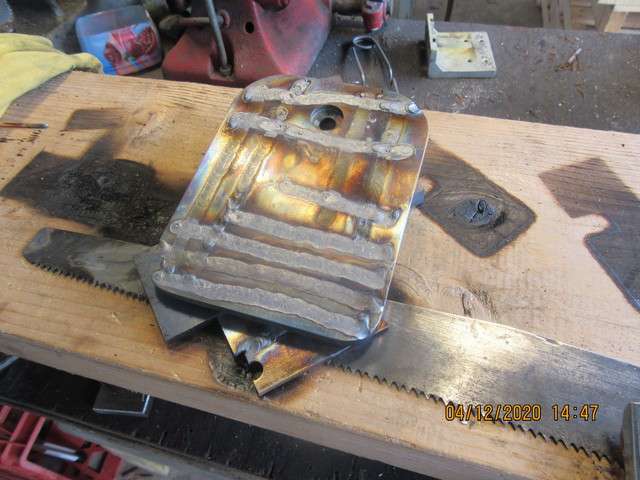

Brian,
Your arc shouldn’t quit because you let up on the pedal, it should only get a bit colder. Make sure your setup is correct, and check that you’re set for a tad bit more amperage than you need. To initiate the puddle, you’ll need a bit more heat, but you’ll throttle it back as soon as she starts to run.
The only reason for it to use more filler rod than gas welding is either over penetration or too big of a puddle.
DC welding will come pretty quick to you if you’re a decent gas welder. It’s all about developing a rhythm and watching the arc closely.
BTW, if you dip your tungsten while practicing, it’s not the end of the world. As long as you haven’t grown a blob on the end it’s okay to keep going. A contaminated practice weld doesn’t need to pass X-Ray...
John W
Your arc shouldn’t quit because you let up on the pedal, it should only get a bit colder. Make sure your setup is correct, and check that you’re set for a tad bit more amperage than you need. To initiate the puddle, you’ll need a bit more heat, but you’ll throttle it back as soon as she starts to run.
The only reason for it to use more filler rod than gas welding is either over penetration or too big of a puddle.
DC welding will come pretty quick to you if you’re a decent gas welder. It’s all about developing a rhythm and watching the arc closely.
BTW, if you dip your tungsten while practicing, it’s not the end of the world. As long as you haven’t grown a blob on the end it’s okay to keep going. A contaminated practice weld doesn’t need to pass X-Ray...
John W
Today was practice running weld beads, using filler wire. Trying different amperage settings and travel speeds. I was concerned that perhaps I wouldn't be able to use this welder, because I couldn't see the arc puddle clearly enough. Found out today that with a higher amperage comes a larger molten weld puddle and it all becomes easier to see. I did order a set of pyrex clear glass welding cups--they don't directly make you a better welder, but they allow you to see much more of what is actually happening. I am, as I said before, amazed at how quickly these welders consume welding rod, compared to oxy acetylene.
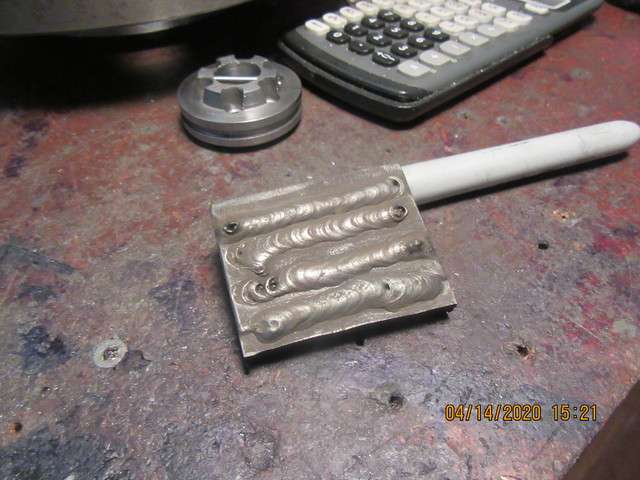



- Joined
- Dec 31, 2010
- Messages
- 819
- Reaction score
- 218
Well. I'd say it uses a lot of filler because you're making a pretty huge bead. 
If you really want a bead that big user thicker filler.
The amperage setting rule of thumb (as a start) is 1 amp per thou of material thickness. That's where amperage should be set. Not set to suit your ability to see
Does your welding helmet have a darkness setting? If you're having trouble seeing turn it brighter.
The darkness setting (as I understand it) has nothing to do with the safety of using it. There is a filter before the darkness device that filters out all the harmful rays. So it's safe to turn the brightness up until you can see. My helmet only goes as low as 10 but I'd like it to go brighter.
You may find it useful to put a bright light on your work as well. I usually weld with the garage door open and the sun coming in helps the visibility.
If you really want a bead that big user thicker filler.
The amperage setting rule of thumb (as a start) is 1 amp per thou of material thickness. That's where amperage should be set. Not set to suit your ability to see
Does your welding helmet have a darkness setting? If you're having trouble seeing turn it brighter.
The darkness setting (as I understand it) has nothing to do with the safety of using it. There is a filter before the darkness device that filters out all the harmful rays. So it's safe to turn the brightness up until you can see. My helmet only goes as low as 10 but I'd like it to go brighter.
You may find it useful to put a bright light on your work as well. I usually weld with the garage door open and the sun coming in helps the visibility.
I am using a #5 cup and the tungsten is sticking out 5/16" past the cup end. Running about 12 to 15 cubic feet of argon per minute.(or hour, not sure which). I have my helmet set at level #9 sometimes at #10. I know about cheater lenses for inside the helmet, but after my eye surgery last year my eyesight is pretty good, and I am wearing my glasses under my welding helmet. I am using a 3/32" tungsten and 3/32" rod The rod is ER70S-2 and the tungsten is 2% thoriated #2PC332.
- Joined
- Dec 31, 2010
- Messages
- 819
- Reaction score
- 218
That all sounds about right.
How about the material thickness and current setting?
Using the pedal ?
How about the material thickness and current setting?
Using the pedal ?
I have been working with different current ranges to see what effect it has on the weld. Rule of thumb seems to be 1 amp per one thousandth of material thickness. I'm still gaining experience with the pedal.
A couple of thoughts. I'll be the first to admit that I am a long, long way from any expertise when it comes to choosing which cup to use, but as I understand it, a #5 cup is pretty small for ordinary work using 3/32" rods and filler. You might want to experiment with something like a #7 and see what difference that makes - though that also means using a bit more argon.
I'll echo Dave that those are really, really large beads for TIG welding. At first I wondered if you might be running hot on the current, and feeding in extra rod to compensate ... but I noticed that at least a couple of those beads look like they are sitting up on the surface a good bit, suggesting that you may be cooling the puddle too much by feeding too much rod, and therefore getting low penetration.
Final thought: if you buy any more electrodes, consider going with 2% lanthanated rather than the thoriated. My reason has less to do with the radioactivity of the latter, and more to do with the fact that the lanthanated electrodes can handle both the DC and the AC - no need to switch to a pure tungsten electrode, or to keep different sets of electrodes on hand.
I'll echo Dave that those are really, really large beads for TIG welding. At first I wondered if you might be running hot on the current, and feeding in extra rod to compensate ... but I noticed that at least a couple of those beads look like they are sitting up on the surface a good bit, suggesting that you may be cooling the puddle too much by feeding too much rod, and therefore getting low penetration.
Final thought: if you buy any more electrodes, consider going with 2% lanthanated rather than the thoriated. My reason has less to do with the radioactivity of the latter, and more to do with the fact that the lanthanated electrodes can handle both the DC and the AC - no need to switch to a pure tungsten electrode, or to keep different sets of electrodes on hand.
This morning I put on my mask and my gloves and my iron underwear, and went over to my welding supplier to pick up some 1/16" tungsten and some 1/16" filler rods. Prepaid by phone to avoid any close contact, material was left for me in vestibule. Came home and wiped everything down with varsol, then washed my hands with dish soap and hot water for 30 seconds. What a giant pain in the arse!!--At any rate, I wanted to see how the tig welder works with a smaller rod and tungsten. I have shown myself that I can lay down a bead with 3/32" tungsten and rod, even if the bead is large and ugly. I have cut up a bunch of 1" x 1/8" flat stock and prepared it in the same manner as the blades in my flywheel/fan. I made a cheap and nasty fixture to hold all of these pieces beside a larger piece of steel, in the same relationship as the fan blades, and will practice later today with the smaller rod.
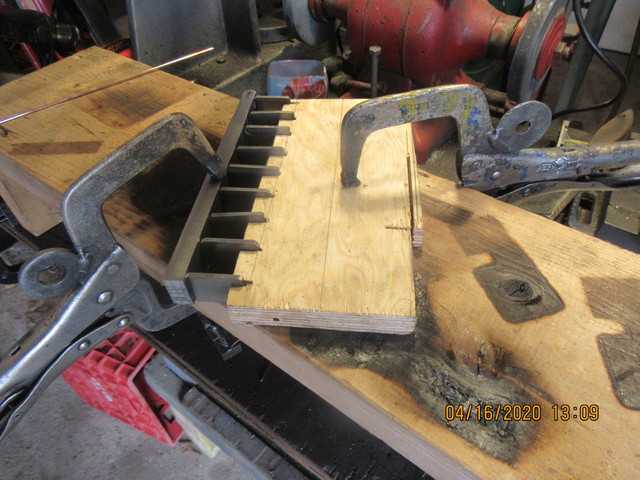

- Joined
- Dec 31, 2010
- Messages
- 819
- Reaction score
- 218
Brian:
Have you tried the lay-wire technique? It is a valid way to weld.
Just lay the filler flat on the surface (or in the joint) and run over it with the torch melding the filler and the base metal until the bead is just slightly proud of the surfaced. This will avoid the ability to add too much filler.
Set the maximum pedal to maybe 90 - 120 amps at full throttle for your 1/8 material.
Keep the tungsten very close to the work.
BTW
I assume you are grinding the metal very clean. TIG is very un-forgiving on dirty metal. Wipe it with acetone as well.
Have you tried the lay-wire technique? It is a valid way to weld.
Just lay the filler flat on the surface (or in the joint) and run over it with the torch melding the filler and the base metal until the bead is just slightly proud of the surfaced. This will avoid the ability to add too much filler.
Set the maximum pedal to maybe 90 - 120 amps at full throttle for your 1/8 material.
Keep the tungsten very close to the work.
BTW
I assume you are grinding the metal very clean. TIG is very un-forgiving on dirty metal. Wipe it with acetone as well.
Similar threads
- Replies
- 27
- Views
- 5K
- Replies
- 3
- Views
- 2K

































![MeshMagic 3D Free 3D Modeling Software [Download]](https://m.media-amazon.com/images/I/B1U+p8ewjGS._SL500_.png)


















